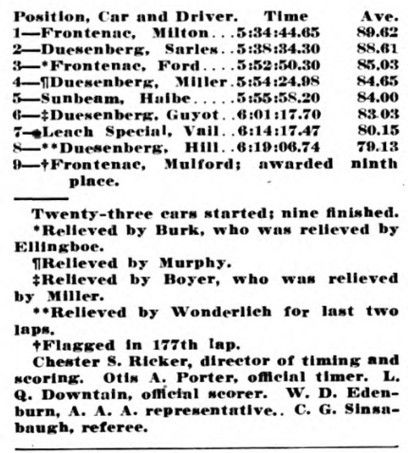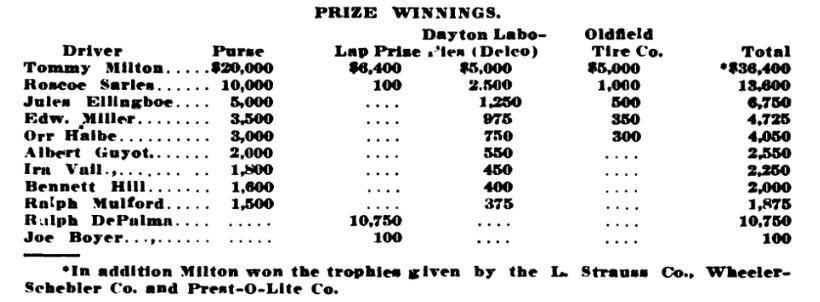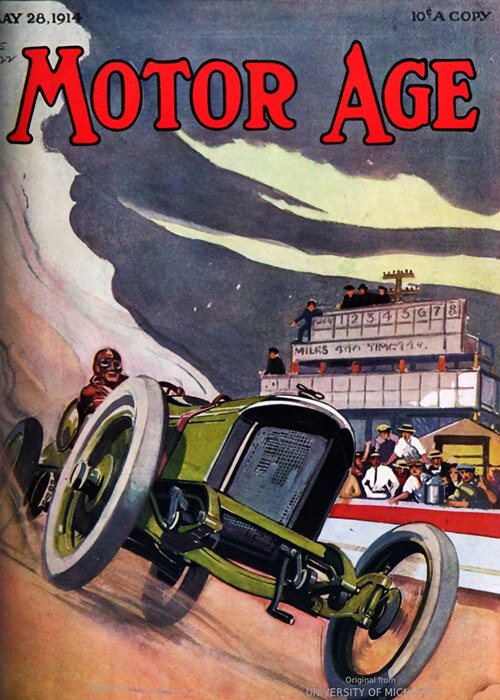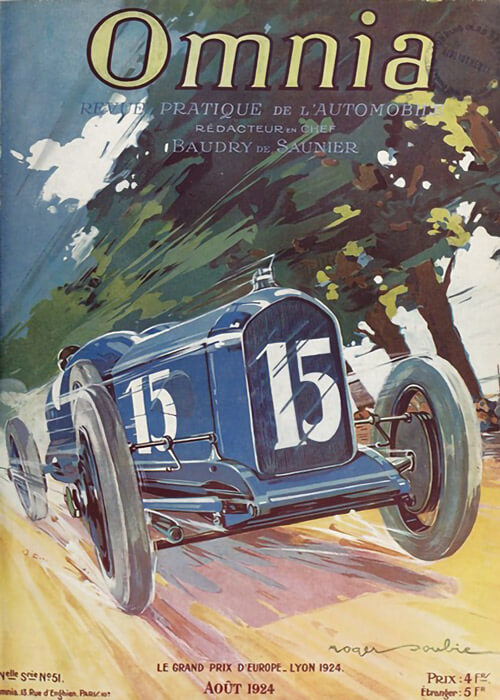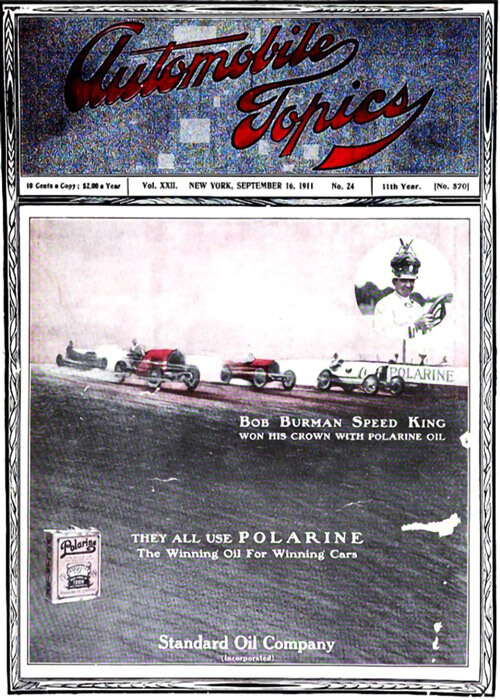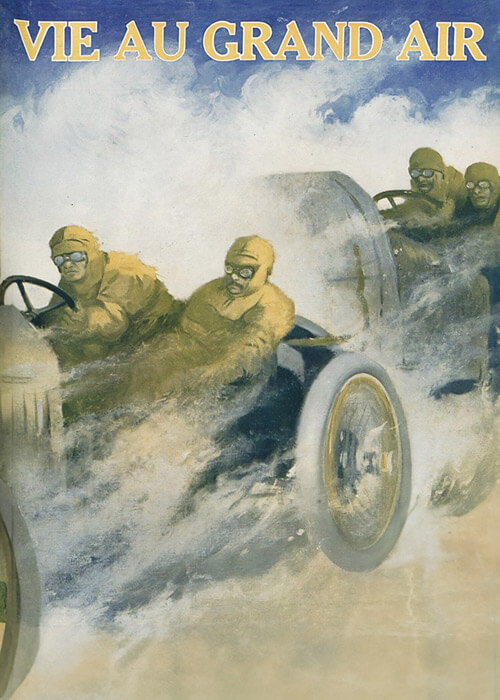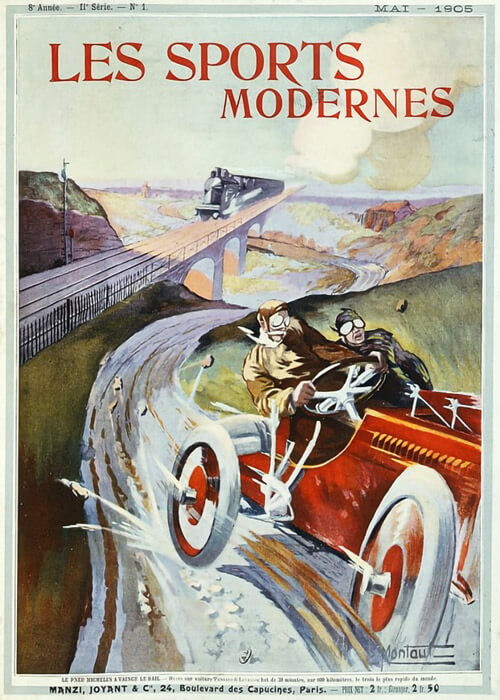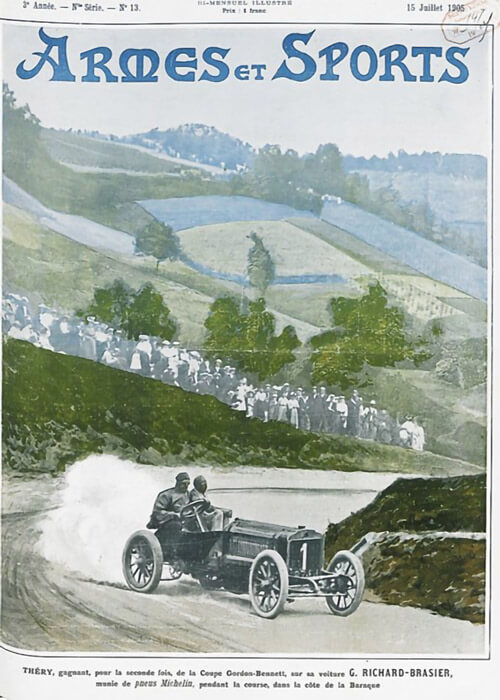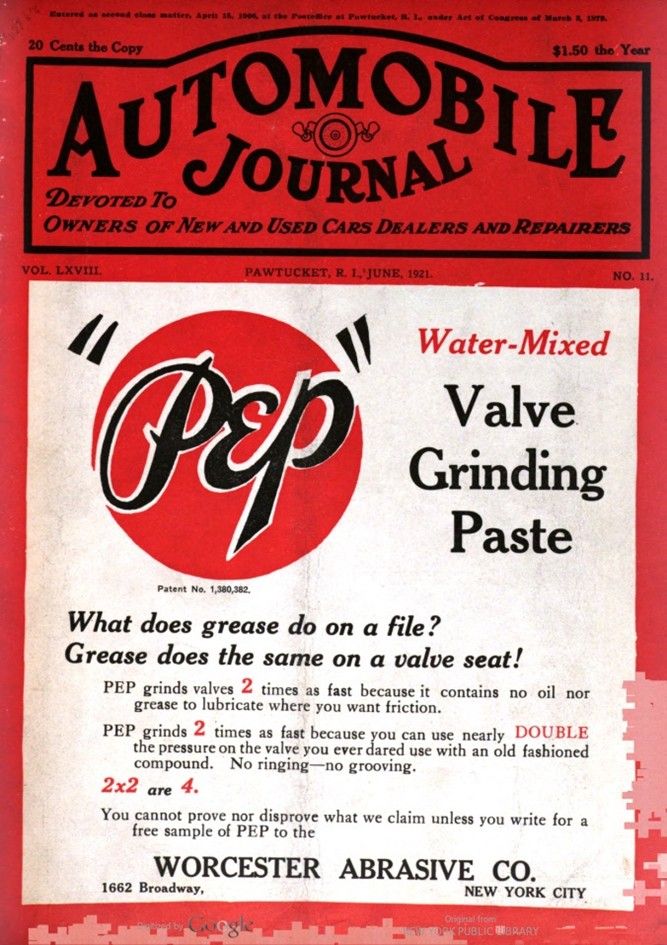
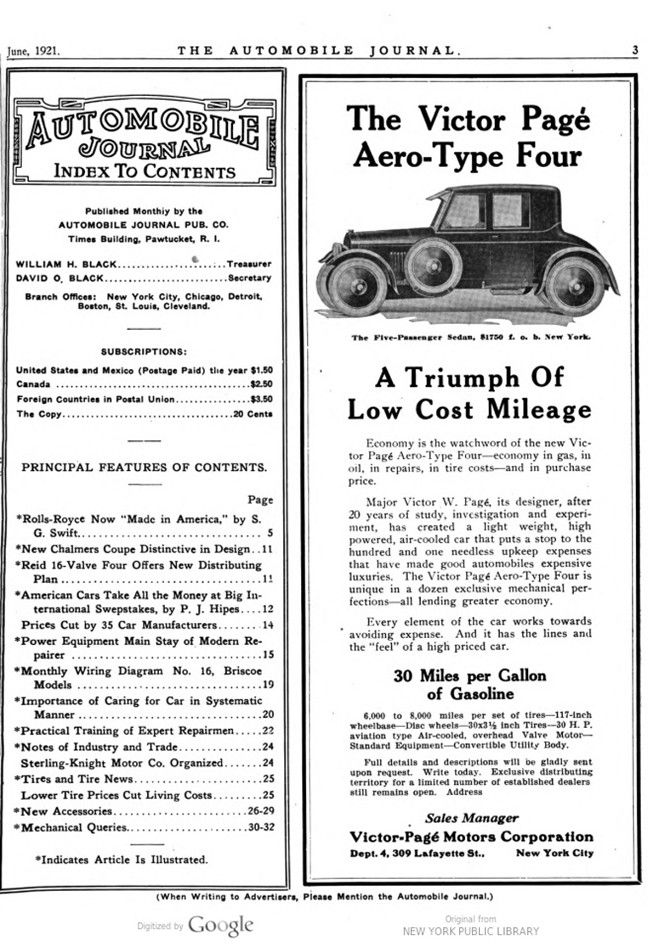
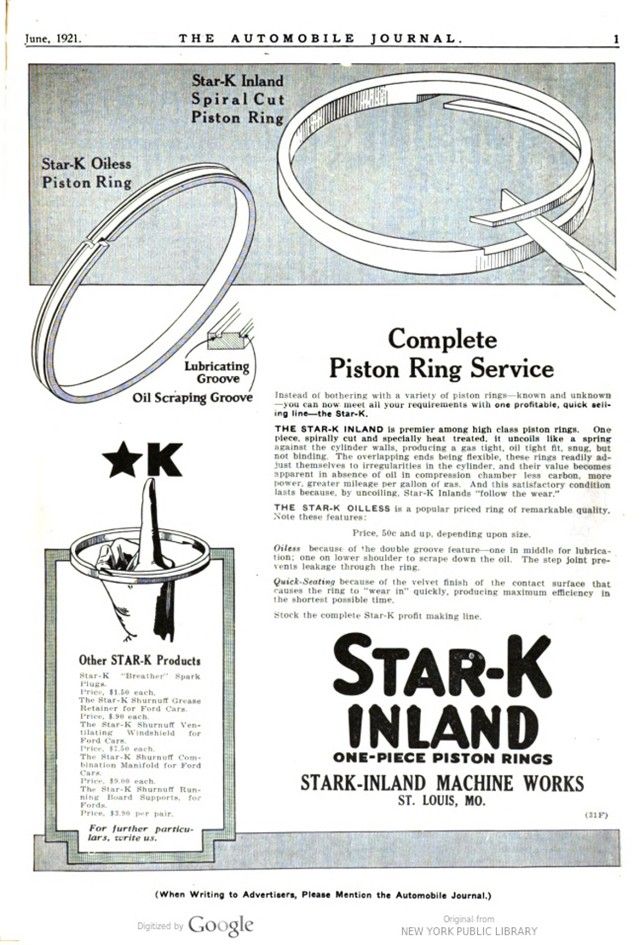
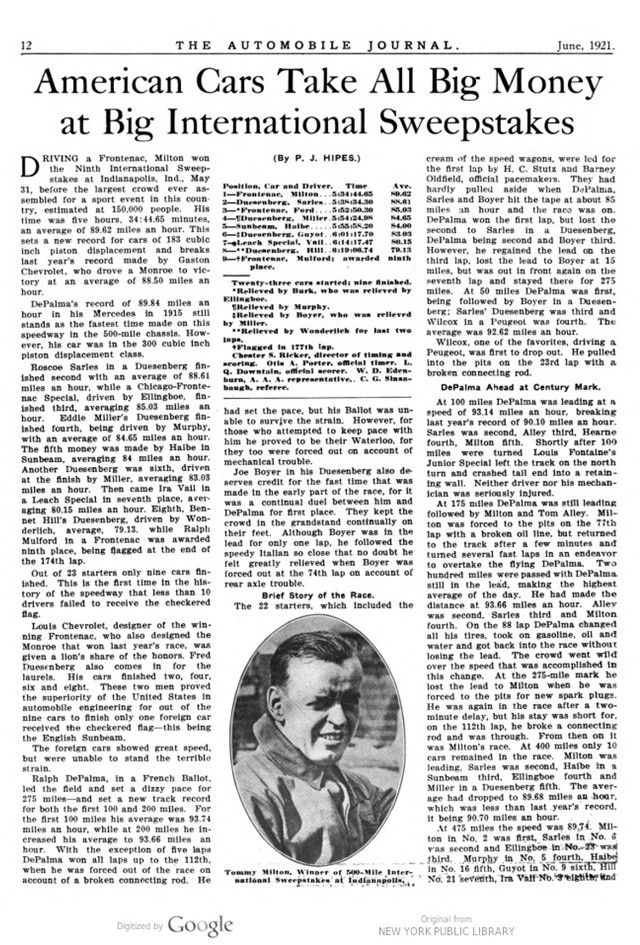
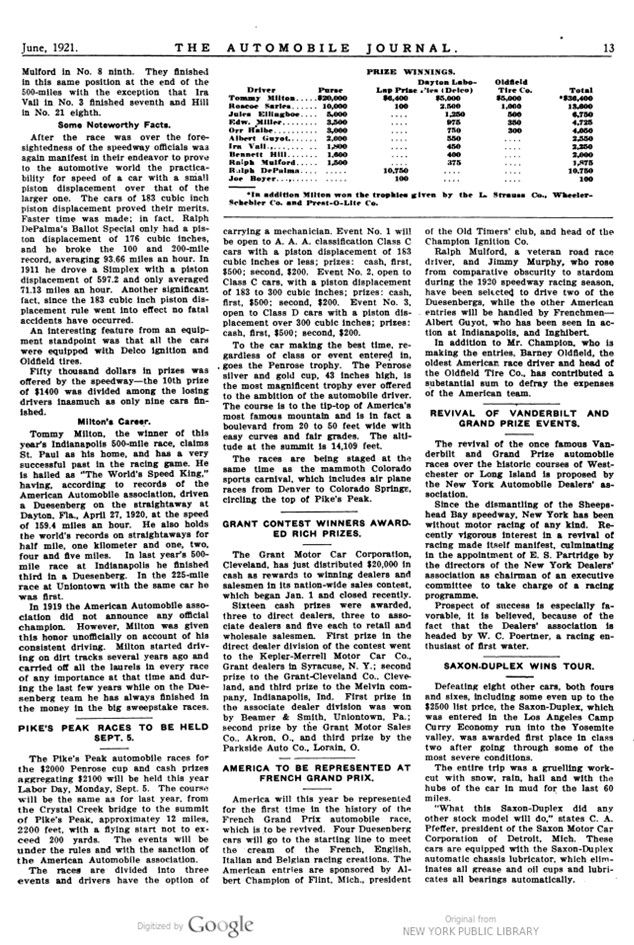
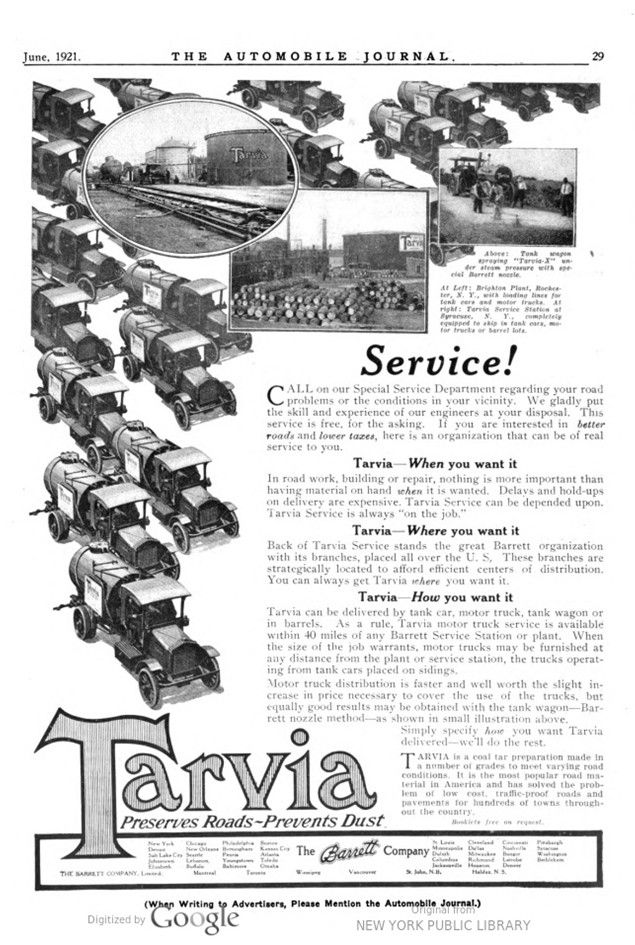
Text and jpegs by courtesy of hathitrust.org www.hathitrust.org, compiled by motorracinghistory.com
The Automobile Journal, Vol. LXVIII (68), No. 17, June 1921
American Cars Take All Big Money at Big International Sweepstakes
(By P. J. HIPES.)
DRIVING a Frontenac, Milton won the Ninth International Sweepstakes at Indianapolis, Ind., May 31, before the largest crowd ever assembled for a sport event in this country, estimated at 150,000 people. His time was five hours, 34:44.65 minutes, an average of 89.62 miles an hour. This sets a new record for cars of 183 cubic inch piston displacement and breaks record made last year’s by Gaston Chevrolet, who drove a Monroe to victory at an average of 88.50 miles an hour.
De Palma’s record of 89.84 miles an hour in his Mercedes in 1915 still stands as the fastest time made on this speedway in the 500-mile chassis. However, his car was in the 300 cubic inch piston displacement class. Roscoe Sarles in a Duesenberg finished second with an average of 88.61 miles an hour, while a Chicago-Frontenac Special, driven by Ellingboe, finished third, averaging 85.03 miles an hour. Eddie Miller’s Duesenberg finished fourth, being driven by Murphy, with an average of 84.65 miles an hour. The fifth money was made by Haibe in Sunbeam, averaging 84 miles an hour. Another Duesenberg was sixth, driven at the finish by Miller, averaging 83.03 miles an hour. Then came Ira Vail in a Leach Special in seventh place, averaging 80.15 miles an hour. Eighth, Bennet Hill’s Duesenberg, driven by Wonderlich, average, 79.13. while Ralph Mulford in a Frontenac was awarded ninth place, being flagged at the end of the 174th lap.
Out of 23 starters only nine cars finished. This is the first time in the history of the speedway that less than 10 drivers failed to receive the checkered flag.
Louis Chevrolet, designer of the winning Frontenac, who also designed the Monroe that won last year’s race, was given a lion’s share of the honors. Fred Duesenberg also comes in for the laurels. His cars finished two, four, six and eight. These two men proved the superiority of the United States in automobile engineering for out of the nine cars to finish only one foreign car received the checkered flag-this being the English Sunbeam.
The foreign cars showed great speed but were unable to stand the terrible strain. Ralph DePalma, in a French Ballot, led the field and set a dizzy pace for 275 miles and set a new track record for both the first 100 and 200 miles. For the first 100 miles his average was 93.74 miles an hour, while at 200 miles he increased his average to 93.66 miles an hour. With the exception of five laps DePalma won all laps up to the 112th, when he was forced out of the race on account of a broken connecting rod. He had set the pace, but his Ballot was unable to survive the strain. However, for those who attempted to keep pace with him he proved to be their Waterloo, for they too were forced out on account of mechanical trouble.
Position, Car and Driver. Time Ave.
1-Frontenac, Milton. 5:34:44.65 89.62
2-Duesenberg, Sarles. 5:38:34.30 88.61
3-*Frontenac, Ford. 5:52:50.30 85.03
4-¶Duesenberg, Miller. 5:54:24.98 84.65
5-Sunbeam, Haibe. 5:55:58.20 84.00
6-Duesenberg, Guyot. 6:01:17.70 83.03
7 Leach Special, Vail. 6:14:17.47 80.15
8-**Duesenberg, Hill. 6:19:06.74 79.13
9-+Frontenac, Mulford; awarded ninth place.
——-
Twenty-three cars started; nine finished.
* Relieved by Burk, who was relieved by Ellingboe.
¶ Relieved by Murphy.
Relieved by Boyer, who was relieved by Miller.
** Relieved by Wonderlich for last two laps.
+ Flagged in 177th lap.
Chester S. Ricker, director of timing and scoring. Otis A. Porter, official timer. L. Q. Downtain, official scorer. W. D. Edenburn, A. A. A. representative. C. G. Sinsabaugh, referee.
Joe Boyer in his Duesenberg also deserves credit for the fast time that was made in the early part of the race, for it was a continual duel between him and DePalma for first place. They kept the crowd in the grandstand continually on their feet. Although Boyer was in the lead for only one lap, he followed the speedy Italian so close that no doubt he felt greatly relieved when Boyer was forced out at the 74th lap on account of rear axle trouble.
Brief Story of the Race.
The 22 starters, which included the cream of the speed wagons, were led for the first lap by H. C. Stutz and Barney Oldfield, official pacemakers. They had hardly pulled aside when DePalma, Sarles and Boyer hit the tape at about 85 miles an hour and the race was on. DePalma won the first lap, but lost the second to Sarles in а Duesenberg, DePalma being second and Boyer third. However, he regained the lead on the third lap, lost the lead to Boyer at 15 miles, but was out in front again on the seventh lap and stayed there for 275 miles. At 50 miles DePalma was first, being followed by Boyer in a Duesenberg; Sarles‘ Duesenberg was third and Wilcox in a Peugeot was fourth. The average was 92.62 miles an hour.
Wilcox, one of the favorites, driving a Peugeot, was first to drop out. He pulled into the pits on the 23rd lap with a broken connecting rod.
DePalma Ahead at Century Mark.
At 100 miles DePalma was leading at a speed of 93.14 miles an hour, breaking last year’s record of 90.10 miles an hour. Sarles was second, Alley third, Hearne fourth, Milton fifth. Shortly after 100 miles were turned Louis Fontaine’s Junior Special left the track on the north turn and crashed tail end into a retaining wall. Neither driver nor his mechanician was seriously injured.
At 175 miles DePalma was still leading followed by Milton and Tom Alley. Milton was forced to the pits on the 77th lap with a broken oil line, but returned to the track after a few minutes and turned several fast laps in an endeavor to overtake the flying DePalma. Two hundred miles were passed with DePalma still in the lead, making the highest average of the day. He had made the distance at 93.66 miles an hour. Alley was second, Sarles third and Milton fourth. On the 88th lap DePalma changed all his tires, took on gasoline, oil and water and got back into the race without losing the lead. The crowd went wild over the speed that was accomplished in this change. At the 275-mile mark he lost the lead to Milton when he was forced to the pits for new spark plugs. He was again in the race after a two-minute delay, but his stay was short for, on the 112th lap, he broke a connecting rod and was through. From then on it was Milton’s race. At 400 miles only 10 cars remained in the race. Milton was leading, Sarles was second, Haibe in a Sunbeam third, Ellingboe fourth and Miller in a Duesenberg fifth. The average had dropped to 89.68 miles an hour, which was less than last year’s record, it being 90.70 miles an hour.
At 475 miles the speed was 89.74. Milton in No. 2 was first, Sarles in No. 6 vas second and Ellingboe in No. 23 was third. Murphy in No. 5 fourth, Haibe in No. 16 fifth, Guyot in No. 9 sixth, Hill No. 21 seventh, Ira Vail No. 3 eighth, and Mulford in No. 8 ninth. They finished in this same position at the end of the 500-miles with the exception that Ira Vail in No. 3 finished seventh and Hill in No. 21 eighth.
Some Noteworthy Facts.
After the race was over the foresightedness of the speedway officials was again manifest in their endeavor to prove to the automotive world the practicability for speed of a car with a small piston displacement over that of the larger one. The cars of 183 cubic inch piston displacement proved their merits. Faster time was made; in fact, Ralph DePalma’s Ballot Special only had a piston displacement of 176 cubic inches, and he broke the 100 and 200-mile record, averaging 93.66 miles an hour. In 1911 he drove a Simplex with a piston displacement of 597.2 and only averaged 71.13 miles an hour. Another significant fact, since the 183 cubic inch piston displacement rule went into effect no fatal accidents have occurred.
An interesting feature from an equipment standpoint was that all the cars were equipped with Delco ignition and Oldfield tires.
Fifty thousand dollars in prizes was offered by the speedway – the 10th prize of $1400 was divided among the losing drivers inasmuch as only nine cars finished.
Milton’s Career.
Tommy Milton, the winner of this year’s Indianapolis 500-mile race, claims St. Paul as his home, and has a very successful past in the racing game. He is hailed as „The World’s Speed King,“ having, according to records of the American Automobile association, driven a Duesenberg on the straightaway at Dayton, Fla., April 27, 1920, at the speed of 159.4 miles an hour. He also holds the world’s records on straightaways for half mile, one kilometer and one, two, four and five miles. In last year’s 500-mile race at Indianapolis he finished third in a Duesenberg. In the 225-mile race at Uniontown with the same car he was first.
In 1919 the American Automobile Association A.A.A. did not announce any official champion. However, Milton was given this honor unofficially on account of his consistent driving. Milton started driving on dirt tracks several years ago and carried off all the laurels in every race of any importance at that time and during the last few years while on the Duesenberg team he has always finished in the money in the big sweepstake races.
Photo captions.
Page 12.
Tommy Milton, Winner of 500-Mile International Sweepstakes at Indianapolis.
